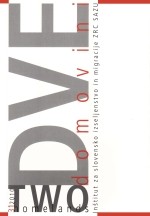Travelling Meanings of the Tuareg Veil in Different Social Contexts
Keywords:
Tuareg, veil, identity, social changeAbstract
The article considers the changing meanings of the Tuareg veil, or taglmust, that have appeared due to the political marginalisation of the Tuareg, changes in relations between the social categories of Tuareg society, settlement in urban environment and tourism. The author confirms that the taglmust represents a symbol of Tuaregness to the outside world as well as for the Tuareg themselves. In everyday uses its regulating function of relations between affines is becoming smaller, while its function as a symbol of ethnic identity and its related aesthetic function are obtaining primary importance. Like the clothing in general, the taglmust also has a dynamic function of communicating identity in different contexts.
Downloads
References
Abu-Lughod, Lila (1988). Veiled Sentiments: Honour and Poetry in a Beduin Society. Berkely, Los Angelos in London: University of California Press.
Barnes, Ruth in Joanne B. Eicher (1992). Introduction. Dress and Gender: Making and Meaning in Cultural Contexts (ur. Ruth Barnes in Joanne B. Eicher). Oxford: Berg, 1–7.
Belliamat, Nadia (2003). Qui sais dancer sur cette chanson, nous lui doneons la cadence: Musique, poésie et politique chez les Touaregs. Terrain 41: 103–120.
Bernus, Edmod (1981). Touaregs nigériens: Unité culturelle et diversité régional d'un peuple pasteur. Paris: Éditiones l'Harmattan.
Brumen, Borut (2001a). Pozabljeni od boga in prekleti od zgodovine: Afrike (tematska številka, ur. Borut Brumen in Nikolai Jeffs). Časopis za kritiko znanosti 29(204, 205, 206): 141–172.
Brumen, Borut (2001 b). How to Use Orientalism: »Good, Dirtty and Evil Tuaregs«. Asia and Africa: Tradition and Modernity (tematska številka). Azijske in Afriške študije 5(1–2): 3–16.
Casajus, Dominique (1987). La tente dans la solitude. La société et les morts chez les Touaregs Kel Ferwan. Paris: Editions de la Miason des Sciences de l'Homme.
Claudot-Hawad, Hélène (1993). Les Touaregs. Portrait en fragments. Aix-en-provence: Édisud.
Claudot-Hawad, Hélène (2001). Éperoner le monde: Nomadisme, cosmos et politique chez les Touaregs. Aix-en-provance: Edisud.
Claudot-Hawad, Hélène (2002). Noces de vent: Épouser le vide ou l'art nomade de voya ger. Voyager d'un point de vue nomade (ur. Hélène Claudot-Hawad). Pariz: Éditions Paris Méditerannée, 11–37.
Debevec, Liza (2010). Kontinuiteta in spremembe v praznični prehrani pri muslimanih v urbanem Burkina Fasu. Dve domovini 31: 37–49.
Duveyrier, Henri (1864). Les Touareg du Nord. Paris: Challamel Aîné.
Eicher, Joanne B. (ur.) (1995). Dress and Ethnicity. Oxford in Washington: Berg.
Ferguson, James (2006). Global Shadows: Africa and the Neoliberal World Order. Durham in London: Duke University Press.
Grégoire, Emanuel (1999). Touaregs du Niger: Le destn d'un mythe. Paris: Karthala.
Hawad (1991). La teshumara, antidote de l'État. Touaregs. Exil et resistance (tematska številka, ur. Hélène Claudot Hawad). Revue du Monde Musulman et de la Méditerranée 57: 123–141.
Henry, Jean Robert (1996) Les Touaregs des Français. Touaregs et autres sahariens entre plusiers mondes. Définitions et redéfinitions de soi et des autres (tematska številka, ur. Hélène Claudot-Hawad). Les cahiers de l'IREMAM 7–8: 248–269.
Inda, Jonathan Xavier in Renato Rosaldo (2008, 2002). Tracking Global Flows. The Anthropology of Globalisation: A Reader (ur. Jonathan Xavier Inda in Renato Rosaldo). Malden, Oxford in Carlton: Blackwell Publishing: 3–47.
Kalčić, Špela (2007). »Nisem jaz Barbika«: Oblačilne prakse, islam in identitetni procesi med Bošnjaki v Sloveniji. Ljubljana: Filozofska fakulteta.
Keenan, Jeremy (2004). The Lesser Gods of the Sahara: Social Change and Contested Terrain amongst the Tuareg of Algeria. London in Portland: Frank Cass.
Kohl, Ines (2009). Beautiful Modern Nomads. Bordercrossing Tuareg between Niger, Algeria and Libya. Berlin: Reimer Verlag.
Lecocq, Baz (2004). Unemployed Intellectuals in the Sahara: The Teshumara Nationalist Movement and the Revolution in Tuareg Society. International Review in Social History 49: 87–109.
Lindisfarne-Tapper, Nancy in Bruce Ingham (ur.) (1997). Languages of Dress in the Middle East. Richmond: Curzon press.
Loftsdóttir, Krístin (2008). The Bush is Sweet: Identity, Power and development among WoDaaBe Fulani in Niger. Uppsala: Nordiska Afrikainstitutet.
Lunaček, Sarah (2008). Percepcija Evropejcev in Američanov ter predstave o Zahodu v Agadezu (Niger) (doktorska disertacija). Oddelek za etnologijo in kulturno antropologijo Filozofske fakultete Univerze v Ljubljani.
Murphy, Robert F. (1964). Social Distance and the Veil. American Anthropologist 66: 1257–1275.
Nicolaisen, Johannes in Ida Niclaisen (1997). The Pastoral Tuareg: Ecology, Culture and Society. London in New York: Thames and Hudson; Copenhagen: Rhodos International Science and Art Publishers.
Rabine, Leslie W. (2002). The Global Circulation of African Fashion. Oxford in New York: Berg.
Reisman, Paul (1977). Freedom in Fulani Social Life: An Introspective Etnography. Chicago in London: University of Chicago press.
Rovine, Victoria L. (2001). Bogolan. Shaping Culture through Cloth in Contemporary Mali. Washington in London: Smithsonian Institution Press.
Rovine, Victoria L. (2009). Viewing Africa through Fashion. Fashion Theory 13(2): 133–140.
Scholze, Marko in Ingo Bartha (2004). Trading Cultures: Berbers and Tuareg as Souvenir Vendors. Between Resistance and Expansion. Dimensions of Local Vitality in Africa (ur. Peter Probst in Gerd Spittler). Münster: LIT Verlag, 71–92.
Spittler, Gerd (1993). Les Touaregs face aux sécheresses et aux famines: Les Kel Ewey de l'Aïr (Niger). Paris: Karthala.
Spittler, Gerd (2010 v tisku). Foreign Cloth and Ethnic Identity of the Kel Ewey. Tuareg moving Global. Socioanthropological Aspects of a Saharan life in Transition (ur. Ines Kohl in Anja Fisher). London in New York: I. B. Tauris Academic Studies.
Van Beek, Walter E. A. (2003). African Tourist Encounters: Effects of Tourism on Two West African Societies. Africa 73(2): 251–290.
Walentowitz, Sakia (2002). »Partir sans quiter«: Rites et gestes autour des déplacements féminin chez les Inesleman de l'Azawagh. Voyager d'un point de vue nomade (ur. Hélène Claudot-Hawad). Paris: Méditerranée, 37–53.
Downloads
Published
How to Cite
Issue
Section
License

This work is licensed under a Creative Commons Attribution-NonCommercial-NoDerivatives 4.0 International License.
Authors guarantee that the work is their own original creation and does not infringe any statutory or common-law copyright or any proprietary right of any third party. In case of claims by third parties, authors commit their self to defend the interests of the publisher, and shall cover any potential costs.
More in: Submission chapter





